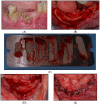Non-Interventional Prospective Observational Study of Platelet Rich Fibrin as a Therapy Adjunctive in Patients with Medication-Related Osteonecrosis of the Jaw
- PMID: 35160132
- PMCID: PMC8837070
- DOI: 10.3390/jcm11030682
Non-Interventional Prospective Observational Study of Platelet Rich Fibrin as a Therapy Adjunctive in Patients with Medication-Related Osteonecrosis of the Jaw
Abstract
Background: Medication-related osteonecrosis (MRONJ) of the jaw is a severe and feared side effect of antiresorptive therapy in the oncological setting. With growing evidence that impaired angiogenesis may represent a key factor in pathogenesis, the aim of this study was to evaluate an autologous platelet concentrate as a possible additive in surgical therapy to optimize vascularization and, subsequently, resolution rates.
Material and methods: A non-interventional, prospective, multicenter study was conducted, and all patients with stage I-III MRONJ, undergoing antiresorptive therapy for an oncological indication, were included. The necrosis was treated surgically without (study arm A) or with (arm B) the addition of an autologous platelet concentrate (platelet-rich fibrin, PRF).
Results: After 5, 14, and 42 days postoperative, wound healing (primary outcome: mucosal integrity) as well as downstaging, pain perception, and oral health-related quality of life (secondary outcome) were assessed via clinical evaluation. Among the 52 patients included, primarily with MRONJ stage I and II, the use of PRF as an additive in surgical therapy did not display a significant advantage for wound healing (p = 0.302), downstaging (p = 0.9), pain reduction (p = 0.169), or quality of life (p = 0.9).
Summary: In conclusion, PRF as an adjunct did not significantly optimize wound healing. Further, no significant changes in terms of downstaging, pain sensation, and oral health-related quality of life were found.
Keywords: MRONJ; angiogenesis; platelet rich fibrin.
Conflict of interest statement
The authors declare no conflict of interest. The funders had no role in the design of the study, in the collection, analyses, or interpretation of data, in the writing of the manuscript, or in the decision to publish the results.
Figures






Similar articles
-
Promising results of surgical management of advanced medication related osteonecrosis of the jaws using adjunctive leukocyte and platelet rich fibrin.BMC Oral Health. 2021 Dec 1;21(1):613. doi: 10.1186/s12903-021-01965-7. BMC Oral Health. 2021. PMID: 34852823 Free PMC article.
-
Treatment of Medication-Related Osteonecrosis of the Jaw Without and With the Use of Advanced Platelet-Rich Fibrin: A Retrospective Clinical Study.J Funct Biomater. 2025 May 14;16(5):180. doi: 10.3390/jfb16050180. J Funct Biomater. 2025. PMID: 40422844 Free PMC article.
-
Prevention and management of drug-induced osteonecrosis of the jaws using platelet-rich fibrin: A clinical feasibility study.Clin Exp Dent Res. 2023 Oct;9(5):791-798. doi: 10.1002/cre2.775. Epub 2023 Aug 21. Clin Exp Dent Res. 2023. PMID: 37605488 Free PMC article.
-
Autologous platelet concentrates as adjuvant in the surgical management of medication-related osteonecrosis of the jaw.Periodontol 2000. 2025 Feb;97(1):287-307. doi: 10.1111/prd.12608. Epub 2024 Sep 30. Periodontol 2000. 2025. PMID: 39345044 Free PMC article. Review.
-
The role of Leucocyte-rich and platelet-rich fibrin (L-PRF) in the treatment of the medication-related osteonecrosis of the jaws (MRONJ).J Clin Exp Dent. 2017 Aug 1;9(8):e1051-e1059. doi: 10.4317/jced.54154. eCollection 2017 Aug. J Clin Exp Dent. 2017. PMID: 28936298 Free PMC article. Review.
Cited by
-
Evaluation of Medication-Related Osteonecrosis of the Jaw (MRONJ) in Terms of Staging and Treatment Strategies by Dental Students at Different Educational Levels.Medicina (Kaunas). 2023 Jan 28;59(2):252. doi: 10.3390/medicina59020252. Medicina (Kaunas). 2023. PMID: 36837455 Free PMC article.
-
Adjuvant effects of injectable platelet-rich fibrin (i-PRF) in the non-surgical periodontal therapy: a split-mouth randomized controlled clinical trial.Clin Oral Investig. 2025 Jun 16;29(7):341. doi: 10.1007/s00784-025-06423-0. Clin Oral Investig. 2025. PMID: 40522340 Clinical Trial.
-
In Vitro Evaluation of the Antibacterial Properties and Cellular Response of Liquid-Leukocyte Platelet-Rich Fibrin Products on Barrier Membranes: A Pilot Study.Dent J (Basel). 2025 May 22;13(6):228. doi: 10.3390/dj13060228. Dent J (Basel). 2025. PMID: 40559131 Free PMC article.
-
Autologous Platelet Concentrates in the Management of Medication-Related Osteonecrosis of the Jaw: A Systematic Review.Medicina (Kaunas). 2025 Aug 21;61(8):1496. doi: 10.3390/medicina61081496. Medicina (Kaunas). 2025. PMID: 40870542 Free PMC article. Review.
-
Reporting Criteria for Clinical Trials on Medication-Related Osteonecrosis of the Jaw (MRONJ): A Review and Recommendations.Cells. 2022 Dec 16;11(24):4097. doi: 10.3390/cells11244097. Cells. 2022. PMID: 36552861 Free PMC article. Review.
References
-
- Bamias A., Kastritis E., Bamia C., Moulopoulos L.A., Melakopoulos I., Bozas G., Koutsoukou V., Gika D., Anagnostopoulos A., Papadimitriou C., et al. Osteonecrosis of the jaw in cancer after treatment with bisphosphonates: Incidence and risk factors. J. Clin. Oncol. 2005;23:8580–8587. doi: 10.1200/JCO.2005.02.8670. - DOI - PubMed
-
- Walter C., Al-Nawas B., Grötz K.A., Thomas C., Thüroff J.W., Zinser V., Gamm H., Beck J., Wagner W. Prevalence and risk factors of bisphosphonate-associated osteonecrosis of the jaw in prostate cancer patients with advanced disease treated with zoledronate. Eur. Urol. 2008;54:1066–1072. doi: 10.1016/j.eururo.2008.06.070. - DOI - PubMed
-
- Khan A.A., Morrison A., Hanley D.A., Felsenberg D., McCauley L.K., O’Ryan F., Reid I.R., Ruggiero S.L., Taguchi A., Tetradis S., et al. Diagnosis and Management of Osteonecrosis of the Jaw: A Systematic Review and International Consensus. J. Bone Miner. Res. 2015;30:3–23. doi: 10.1002/jbmr.2405. - DOI - PubMed
-
- Ruggiero S.L., Dodson T.B., Fantasia J., Goodday R., Aghaloo T., Mehrotra B., O’Ryan F., American Association of Oral and Maxillofacial Surgeons American Association of Oral and Maxillofacial Surgeons position paper on medication-related osteone-crosis of the jaw—2014 update. J. Oral Maxillofac. Surg. 2014;72:1938–1956. doi: 10.1016/j.joms.2014.04.031. - DOI - PubMed
Grants and funding
LinkOut - more resources
Full Text Sources

